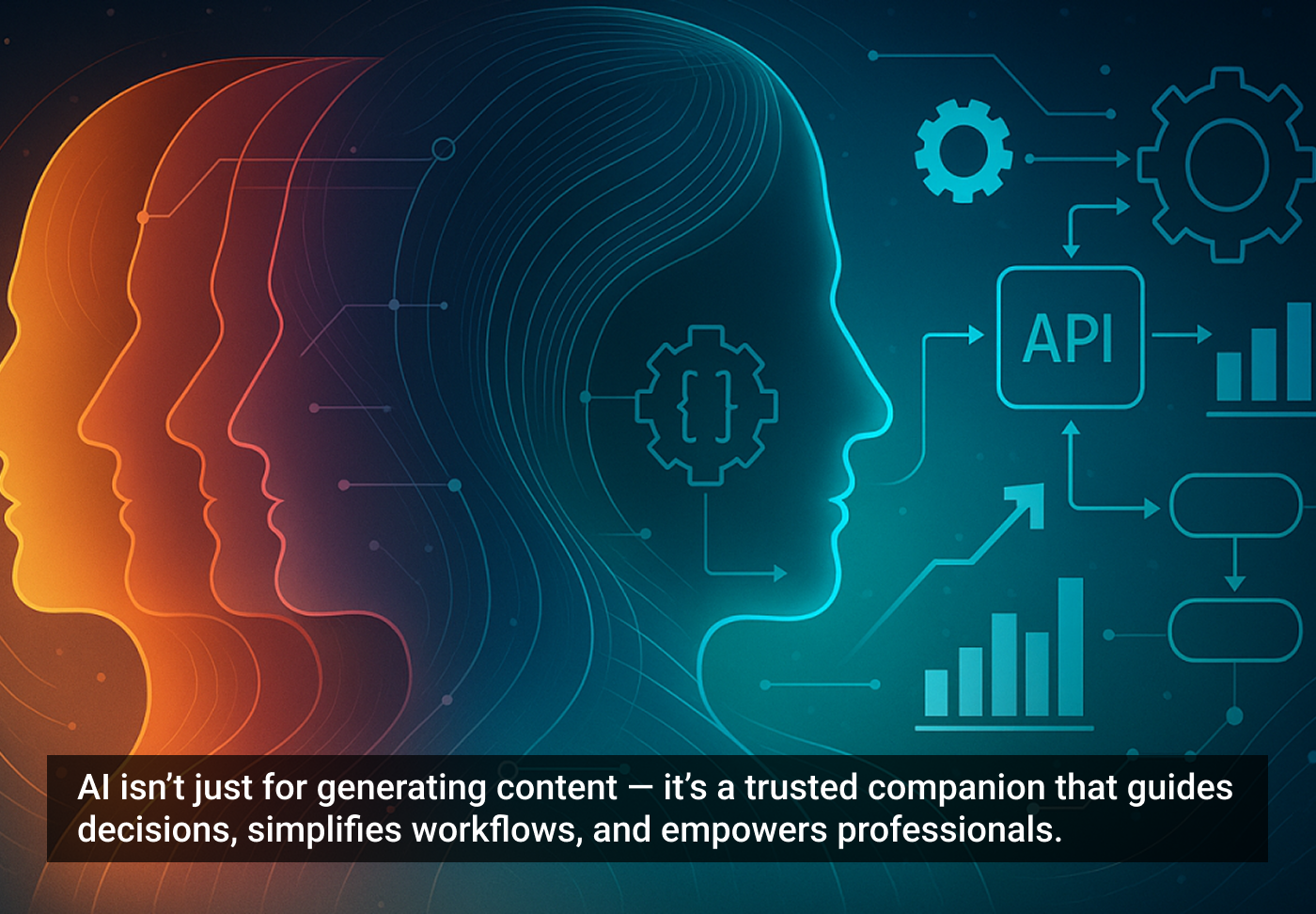Artificial Intelligence has become the shiny badge every product team feels pressured to wear. Scroll through tech launches, and you’ll find “AI-powered” splashed everywhere, from note-taking apps to recruitment portals. The pattern is clear: AI is being used primarily as a generative facilitator. Companies embed chatbots or content generators to claim innovation, hoping for quick engagement wins. But let’s be honest: most of these implementations are shallow, repetitive, and increasingly frustrating to users.
AI should not be a novelty layer. It should be an integrator, a system that guides processes, simplifies complexity, and supports humans in making better, faster, more confident decisions. This article challenges the prevailing mindset and makes the case for AI not as a gimmick, but as a strategic business companion. I have worked with AI as a product manager and included real-world examples throughout this piece to illustrate the challenges and breakthroughs my teams have experienced.
Here are the Quintessential Truths of Shaping AI as a Business Product Integrator.
1. Generative alone does not equal intelligent
The tech industry has confused content creation with intelligence. Generative AI can produce text, images, or recommendations, but these outputs are probabilistic, not deterministic. They mimic intelligence but often lack reliability or contextual awareness.
Users don’t want to be impressed by AI’s ability to generate paragraphs. They want outcomes they can trust in workflows that actually matter.
I once observed a sales team spend hours editing AI-generated prospecting emails that sounded robotic. The promise of productivity backfired. It reminded me that AI’s role isn’t to generate more noise but to integrate into workflows that reduce noise altogether.
2. AI should be a guide, not a gatekeeper
When AI is positioned as the decision-maker, it creates user anxiety. People don’t want their processes dictated by opaque algorithms. Instead, AI should act as a guide, pointing to the best options, surfacing insights, and empowering users to make final calls.
Over-automation risks alienating professionals who value their judgment. Blind trust in probabilistic models is reckless.
In a compliance project, leadership initially pushed for full AI-driven approvals. I argued for a guided-review model: AI highlighted risks, humans made the call. Adoption soared because employees felt supported, not replaced.
3. Transparency builds trust
The black-box nature of AI breeds skepticism. If users don’t understand how recommendations are made, they won’t trust them. Integrative AI should surface reasoning, display confidence levels, and make its logic visible.
Trust is not earned by branding something as “AI-powered.” It’s earned by showing users how AI reached its conclusion.
While rolling out a machine learning pricing tool, we included explainability panels: “The system recommends this because of X, Y, Z.” Initially seen as a UX burden, it became the most used feature. Users valued transparency over magic.
4. Efficiency trumps novelty
Novelty drives short-term adoption. Efficiency drives long-term loyalty. AI should cut steps, reduce bureaucracy, and eliminate redundant decision-making. If your AI feature adds more clicks than it saves, it’s not intelligent, it’s cosmetic.
Users won’t tolerate extra friction wrapped in an “AI” label. Convenience wins every time.
At one company, we launched a generative report builder. Instead of speeding up reporting, it created messy drafts that required even more editing. We replaced it with an AI-assisted filter that pre-sorted key metrics. The time savings spoke louder than any demo.
5. Edge cases will always exist
AI is probabilistic. It excels in patterns, but stumbles in anomalies. That’s why building rigid systems where AI dictates everything sets products up for failure. True integrative AI anticipates edge cases and offers graceful handoffs to humans.
AI doesn’t eliminate complexity; it shifts it. Ignoring exceptions is reckless product management.
During an AI-enabled claims processing rollout, the system mishandled rare but critical cases. We integrated an “escalate to human” option with clear triggers. Complaints dropped, trust grew, and users respected that AI knew when not to act.
6. Companion, not bureaucrat
The future of AI is companionship, not control. It should act like an expert colleague, guiding, simplifying, and catching mistakes, not a bureaucrat enforcing rigid paths. If AI feels like a blocker, you’ve built the wrong product.
Nobody wants an AI that complicates workflows under the guise of structure.
In designing an AI assistant for workflow automation, I tested early prototypes with frontline employees. Their feedback was blunt: “Stop making me ask the bot permission.” We reoriented the design so AI offered recommendations but never stood in the way.
7. Context is king
Generic AI experiences feel clunky because they ignore context. Real integration means AI understands the user’s role, domain, and workflow, and tailors outputs accordingly.
Without contextual intelligence, AI is just autocomplete with good PR.
A generic chatbot pilot in a SaaS platform left users annoyed. Switching to a role-aware AI that adjusted its tone, detail, and next steps based on user profile transformed engagement from complaints to compliments.
8. UX matters more than the model
Even the most advanced model fails if wrapped in poor UI. Users don’t care about LLM architecture; they care about intuitive, transparent, and efficient experiences. Integrating AI into business products requires design discipline as much as model sophistication.
Great AI with bad UX is indistinguishable from bad AI.
In one project, the team obsessed over model accuracy while neglecting interface design. Users abandoned the tool. When we redesigned the workflow to highlight AI suggestions inline with tasks, adoption skyrocketed, without changing the model.
9. AI should enhance professional confidence, not undermine it
The best AI integrations amplify user expertise. They provide shortcuts, highlight insights, and act as safety nets. If users feel dumber, slower, or second-guessed, your AI is failing.
AI should potentiate human intuition, not replace it.
I’ve seen AI calculators in finance tools undermine trust by overriding analysts’ inputs. The winning approach was assistive AI: flagging inconsistencies, offering alternate calculations, and reinforcing confidence instead of eroding it.
10. The strategic shift: from generators to integrators
AI’s destiny in product management is not to dazzle with gimmicks but to integrate deeply into workflows as trusted guides. The leap from facilitation to integration is what will separate forgettable apps from transformative platforms.
If your AI strategy is just “add a chatbot,” you’re already behind.
The most impactful AI feature I’ve seen wasn’t generative at all. It was an intelligent routing system that guided users to the fastest resolution path based on data. It didn’t look like AI, but it felt like magic because it solved a real pain.
Final thoughts: AI as the product integrator
The next wave of AI will not be measured in generated words or flashy demos. It will be judged by how seamlessly it integrates into business processes, how well it guides professionals toward better outcomes, and how much trust it earns along the way.
To my fellow product managers: stop chasing AI gimmicks. Start building AI companions that simplify, guide, and empower. Because the products that win won’t be the ones that generate more, they’ll be the ones that integrate better.
The article originally appeared on LinkedIn.
Featured image courtesy: Mauricio Cárdenas.








